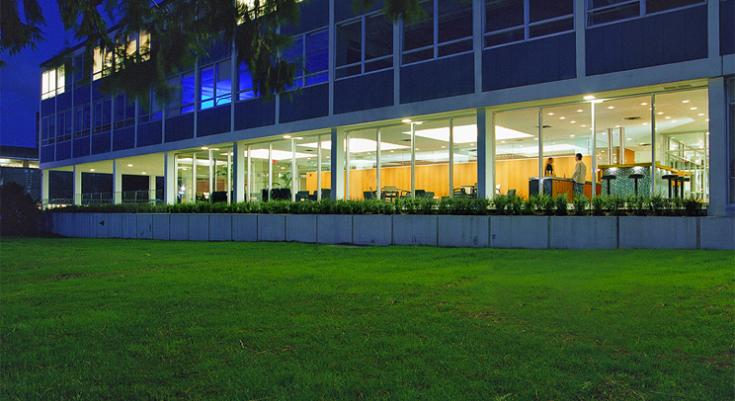
If you’ve been on a night-time walk around Buchanan Courtyards or Agricultural Road recently, you might have noticed a change in the lighting. These recently finished projects are the first ones on campus to follow the new outdoor lighting guidelines established in last year’s Public Realm Plan. And when the sun goes down, they have a different feel to them.
“We are trying to increase the light levels, to enhance the comfort level—and the Wow! Factor,” explains Siu Tse, Associate Director of Infrastructure Services Planning. “We want you to feel safe. And to say, ‘Isn’t that pretty!’”
When the university developed the Vancouver Campus Plan, Campus and Community Planning (C+CP) decided to develop and implement a new master plan for lighting.
“We had heard from the campus community that some people were concerned about safety and security,” says Dean Gregory, the university’s Landscape Architect tasked with planning the campus landscape.
“As we become a more 24/7 campus, with more people out and about at night, it’s becoming more of an issue. And because we live at such a northern latitude, in the winter, when most students are here, the days are short and it’s often dark. It’s also an aesthetic thing—we want to make sure the campus looks good.”
There are also concerns about light trespass and light pollution, Gregory notes. In the past, the aim was to create the overall sense of a full, moonlit evening; the approach now is to use more directed lighting in places where it’s needed. “We only need to light up certain areas—we don’t need to light up the forest, for instance, or in residential areas, don’t want lights that shine into people’s windows. We just want the light to go where it’s wanted” — in general, onto the path.
Overall, the new policy is set to increase the amount of electricity used on outdoor lighting by about 30 percent. But the landscape architects are working with the Sustainability Office and Plant Operations to minimize the environmental and financial costs as well as the amount of maintenance the new lights will require.
“We want to balance efficiency with aesthetics with maintenance,” says Gregory. “It can be a challenge to meet those sometimes-conflicting needs.”
“The new plan has two priorities,” says Orion Henderson, Director of the UBC Sustainability Office: “safety and celebrating the important buildings and other structures around campus. The result is a net increase in energy use on campus. However, we’re trying to figure out how we can do this in the most efficient way possible.”
One way is to use the latest, most energy-efficient lamps; tests are now underway on LED, induction and metal halide (or HID) technologies. Another option is lighting control, which the campus has very little of at present. With more sophisticated control, engineers can dim the lighting down to the minimum safety levels at certain times, such as after 11 or 12 P.M., when there are less people about.
Henderson says that these strategies could reduce energy consumption by as much as 30 percent, “so if we get this right, we can have more lighting and still end up with similar energy use. We can at least try to achieve that, once we’ve evaluated the different technologies.”
All new landscaping and public realm projects will include these lighting improvements. For the work that has just begun on Main Mall and University Boulevard, for instance, Tse says that C+CP is doing two kinds of lighting. “The drop-down pedestrian lighting focuses on the pathways, while the other lights are floodlights shining into the trees and onto the central lawn. They give quite an emotional feel when you first come onto the route. These are some of our main ceremonial routes, so we wanted to do that. The light levels will be more than enough for safety, but they’ll also be quite warm, so you’ll feel comfortable. Like you do when you go for a stroll in Gastown.”
“And of course, we’re always looking at the sustainability side, trying to find long-lasting, efficient options. And control lighting levels, so that we can reduce our energy consumption.